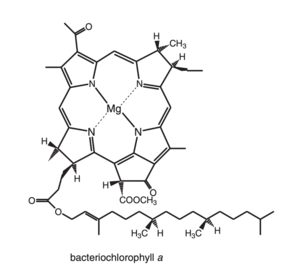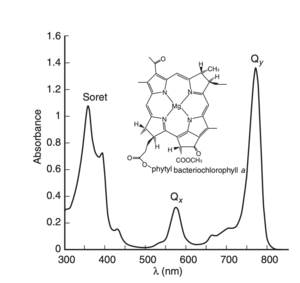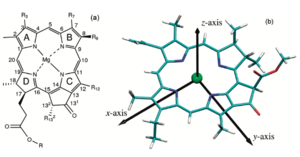As mentioned light-harvesting complexes are important for Purple bacterial to maximize the spectrum of light avaiable to them, modifyng the absorption properties of their chromophores;
In the LHC The proteins help to determine the disposition of the pigments, with, as it will be explained, end up influencing their absorption spectra, together with other factors such as inter-pigment geometries and their interactions with protein and membrane environments.
[7]
Pigmentwise, purple bacterias in general contain bacteriochlorophyll a or b, never both and in the case of Rhodopseudomonas acidophila, bacteriochlorophyll a, also abreviated to BChl a, associated with carotenoids, non-covalently bound to two low-molecular-weight hydrophobic apoproteins [8]
It is the principal chlorophyll-type pigment in the majority of anoxygenic photosynthetic bacteria and acomodated several structural changes in comparinson to the typical clorophin pigments, specially regarded its symmetry, witch impose effects on its spectral properties.
[9]
By clicking is possible to visualise that there are two types of bacteriochlorophylll in diferent conformations regarding the whole complex, which explains why this pigments can absorb in two diferent frequencys. We can visualisy there are B800 pigments wich form a ring parallel to the plane of the
membrane that the complex is embedded in. Acording to the same authors The B800 pigments "are weakly coupled to each other and are at a distance of approximately 21 Å from each other". This independence hey keep as molecules anwer for their spectral absorption range.
The rest of the bacteriochlorophylls can be seen arranged perpendicularly to the plane of the membrane and consist of The pigments that absorb at 850. Each subunit complex has two molecules of bacteriochlorophyll B850 arranged as a closely coupled dimer, which constitue a band of 16 or 18 pigments when the subunit complexes assemble into the LH2 complex. "This band of B850 pigments are all strongly exciton-coupled together, so excitations are effectively delocalized over much or all of the entire band, rather than being effectively localized in a single pigment for a short while and then hopping to another pigment, as is the case with the B800 pigments".
To further understand the diference on absorbance between the bacteriochlorophylls in a more independet state and in a more conjugated state is important to understand the concept of delocalization of energy, which is the extra stability a compound has as a result of having delocalized electrons.[10] " Electron delocalization is also called resonance. Therefore, delocalization energy is also called resonance energy."
"Charge delocalization is a stabilizing force because it spreads energy over a larger area rather than keeping it confined to a small area. Since electrons are charges, the presence of delocalized electrons brings extra stability to a system compared to a similar system where electrons are localized."
Since conjugation brings up electron delocalization, it follows that the more extensive the conjugated system, like B850 molecules, the more stable the it is, at the same time that its potential energy is lower [11]
Acordig to [12], The spectra of photosynthethic pigments in gereral can be described by using the “four orbital” model. In this model there are for p molecular orbitals involved, simplified as HOMOs (highest occupied molecular orbitals) and LUMOs ( lowest unoccupied molecular orbitals).
The two lowest-energy transitions are called the Q bands, they are in the visible region
of the spectrum and are the most important for the photophysics, and the two higher-energy ones are known as the B bands or Soret bands, and are found in the UV region composing of a large series of electronic transitions.[13]
[14].
In order to further understand how the pigments respond to light excitation, its important to visually the moleculas x and y axis. By convention, the y molecular axis is defined as the axis passing through the N atoms of rings A and C as show in the figure;
[15]. Acording to
[16] "The longest-wavelength transition is invariably polarized along the y
axis of the molecule and is therefore known as the Qy transition. This means that the absorption will be strongest if the electric vector of plane-polarized exciting light is parallel to the y molecular axis of the pigment. The exciting light couples to the p electrons of the
molecule and rearranges them somewhat during the transition".
This Qy transition causes a shift in electron density along the axis and its called a transition dipole.
Like other dipole moments, this dipole refers to a difference in charge from one region of a molecule to another.
[17]
Energy transfer mechanism
When a Bchl molecule is excited by light, its first excited singlet state lasts for a few nanoseconds!. The light-harvesting system must be able to transfer the absorbed energy to the reaction centre in a shorter time than this. Some of the important features that allow this to take place are revealed by the structure reported here. Previous biophysical studies (reviewed in ref. 1) have shown that energy transfer within the LH2 complex can occur from the BSOO to the BS50 BChl a molecules in 0.7 ps. Once the energy reaches the BS50 molecules, it is rapidly transferred among them. This is seen as an ultrafast depolarization of the excited state on the 200-300 fs timescale. Energy transfer from LH2 to LHI occurs in the 5-20 ps time range, but with LH2 alone the decay of the S50 nm excited singlet state takes 1.1 ns. The ring of BS50 Bchl a molecules acts rather like a 'storage ring', with the excited state rapidly delocalized over a large area. The delocalization is facilitated by a highly hydrophobic environment which reduces the dielectric constant, allowing coupling over large distances. The energy is then available for transfer from any part of the ring to any neighbouring LHI complex. It is clear from electron microscopy imaging of the LHI complex 13 , and from a comparison of the primary structures3 of the LH2 and LH I complexes, that the structure of the LHI complex is similar to that of LH2 (with a larger ring). With such a ring structure, there is no requirement for the
LHI complex to have a special orientation to receive energy from the LH2 ring. Furthermore, because the BS75 Bchl a
molecules in LHI are liganded to homologous histidine residues, as in LH2, it is likely that the BS50 and BS75 bacteriochlorophyll rings will be at the same point in the membrane. The overall effect will be to allow energy transfer from any LH2 to any LHI complex that is within range, without regard to the orientation of either complex. This reduction in the dimensionality of the process will lead to a further kinetic gain. Previous studies have shown that the carotenoid in this LH2 complex acts as an efficient accessory light-harvesting pigment (>50%)7. The excited singlet lifetime of carotenoids is usually less than 10 pS8. Therefore, if energy transfer is to compete successfully with these rapid de-excitation processes, the carotenoid must be located very close to the acceptor bacteriochlorophylls8, as seen in the structure.
[18]
The carotenoid molecules have an extended conformation and lie generally perpendicular to the plane of the membrane, with close approach (3.4–3.7 Å) to both the B800
and the B850 pigments.
Structure
The differences between the LH1 and LH2 complexes reside in their protein/pigment stoichiometry and modes of oligomerization. Structural studies have shown that LH2 complexes are formed from eight or nine αβ subunit oligomers
Structural studies have shown that LH2 complexes are formed from nine ab Alpha Beta subunits</scene>, organised in a ring of inner a (hollow cylinder of radius 18 A) and outer (outer cylinder of radius 34 A). The a-apoprotein contains 53 amino acids, and the p-apoprotein 41.[19]
The Bchl a-binding histidines of the a (His 31) and
b (His 30) apoproteins face outwards and inwards, respectively,
forming a complete ring of 18 overlapping Bchl a molecules. For
these molecules, the planes of the bacteriochlorins are parallel to
the membrane normal and their centres are approximately loA
from the presumed periplasmic membrane surface. The nine
remaining Bchl a molecules are packed between the p-apoprotein
helices a further 16.5 A into the membrane with their bacteriochlorin rings parallel to the membrane surface.
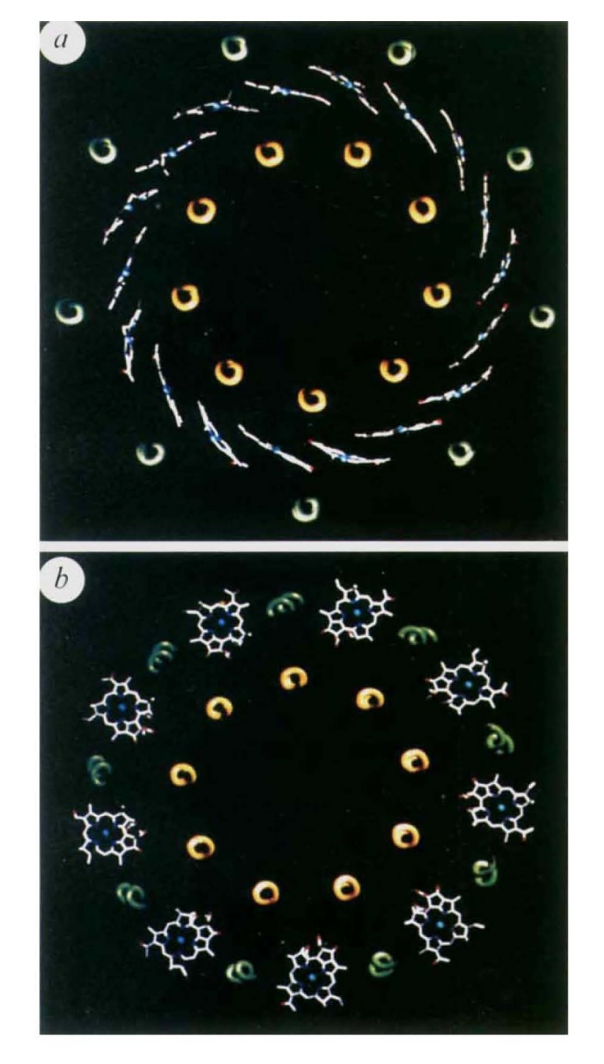
. Circular
dichroism analysis of these absorption bands has led to the conclusion that the Bchl a molecules that absorb at 800 nm are
largely monomeric, whereas those absorbing at 850 nm are
strongly exciton-coupled5
• Conserved histidine residues in the
apoproteins have been shown, by resonance Raman spectroscopy, to be liganded to the Mg at the centre of the Bchl a that
absorbs at 850 nm
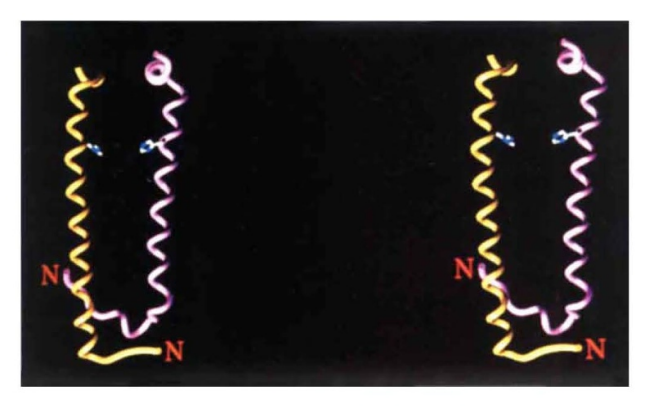 [20]
[20]
In between the b-peptides and close to the cytoplasmic surface, aswell as Near the
periplasmic surface, and between a and b- peptides, are , they are responsible for near infrared absorption, being called B800 and B850.
pigments are also present and absorb in the visible part of the spectrum and perform the additional role of protection against photo-induced oxidation, in the case of the LHC II the carotenoid present is rhodopin glucoside.
This is a sample scene created with SAT to by Group, and another to make of the protein. You can make your own scenes on SAT starting from scratch or loading and editing one of these sample scenes.
